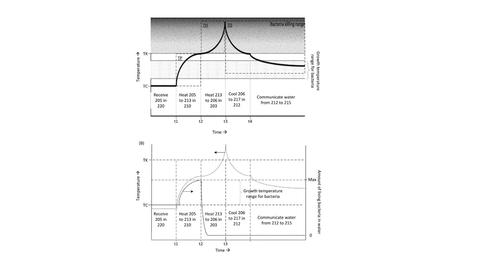Water Heating System With Legionella Control
Published Patent Application Number: 2021/0215353 A1/ 17/146,330
Problem
patent description
Legionella pneumophila is an opportunistic pathogen in premise plumbing systems (OPPPs) that is responsible for Legionnaires' Disease, which is a form of pneumonia with a 10% mortality rate. According to the Center for Disease Control, there are more than 6000 confirmed cases of Legionnaires Disease in the United States each year; however, experts agree that the actual number of cases is likely one order of magnitude higher. Legionella pneumophila are regularly present in water sources, and under certain circumstances they can thrive in premise plumbing systems and multiply into colonies that are capable of infecting humans. For this reason, designing and operating components of premise plumbing systems can be a very effective strategy for reducing the risk of exposing people to these pathogens. One strategy that is known to be effective at reducing the pathogens in a plumbing system is to elevate the water temperature; however, if the water is too hot it can result in severe injuries from scalding and waste energy. This has sparked a debate on finding an appropriate temperature to balance the objectives of effectiveness, safety, and energy; and this debate has continued for decades. This disclosure describes a new concept for a hot water heating system that uses an unmixed, liquid-to-liquid heat exchanger to transfer thermal energy between water entering and exiting the storage tank. Strategically employing a heat exchanger in the manner described here allows operation of the water heater at a much higher temperature than is permitted in conventional applications, and this will increase its effectiveness for pathogen control. It also cools the water leaving the heater down to a temperature that is safe for distribution within the plumbing network by recovering the thermal energy in the hot water. This novel approach is therefore capable of simultaneously addressing the goals of water quality, energy efficiency, and safety from scalding.

Invention
A bacteria abatement water heater abates bacterial growth and includes a fluid-isolated heat exchanger; a water heating container that heats water to a high water temperature that is greater than or equal to a kill temperature for bacteria; a hot water delivery conduit including a transitional cooling zone in thermal communication with the fluid-isolated heat exchanger and that provides bacteria-free water from the water heating container at a safe temperature.
Features
One method of handling legionella in plumbing systems is to carefully manage the temperatures within the hot water side of the water heating system and piping network. The idea behind this approach is to maintain water temperatures above those at which colonies will grow, approximately 49C (120F). This approach, however, is limited by the fact that people can be injured if they are exposed to water that is too hot, and for this reason there are code requirements that do not allow water in the piping networks to be much hotter than this temperature. While this approach helps to minimize the growth of colonies, it does not eliminate the risk and it may be complicated to implement. The temperature at which to maintain hot water in the system has been debated by epidemiologists, health and safety professionals, and engineers for decades.
This invention combines a traditional style water heater with a liquid-to liquid, unmixed heat exchanger connected to the inlet and outlet of the hot water storage tank. By connecting the heat exchanger in this manner, one can maintain a much hotter temperature (>71 °C (160 °F)) within the storage tank; hot enough to kill all of the live bacteria before it enters the piping network. The heat exchanger recovers the energy from the ultra-hot water leaving the storage tank, thereby cooling it down to a safe distribution temperature, and that energy is used to preheat the cold water that enters the storage tank, thereby conserving energy. The key benefit is that this concept will force all of the water flowing into the building's hot water distribution system through a single point that is maintained at a temperature so high that the bacteria cannot survive, thereby eliminating the risk of exposure to the building occupants. This concept also achieves the objectives of energy conservation and reduced risk of scalding.

